How do Solar Cells work? Photovoltaic Cells Explained
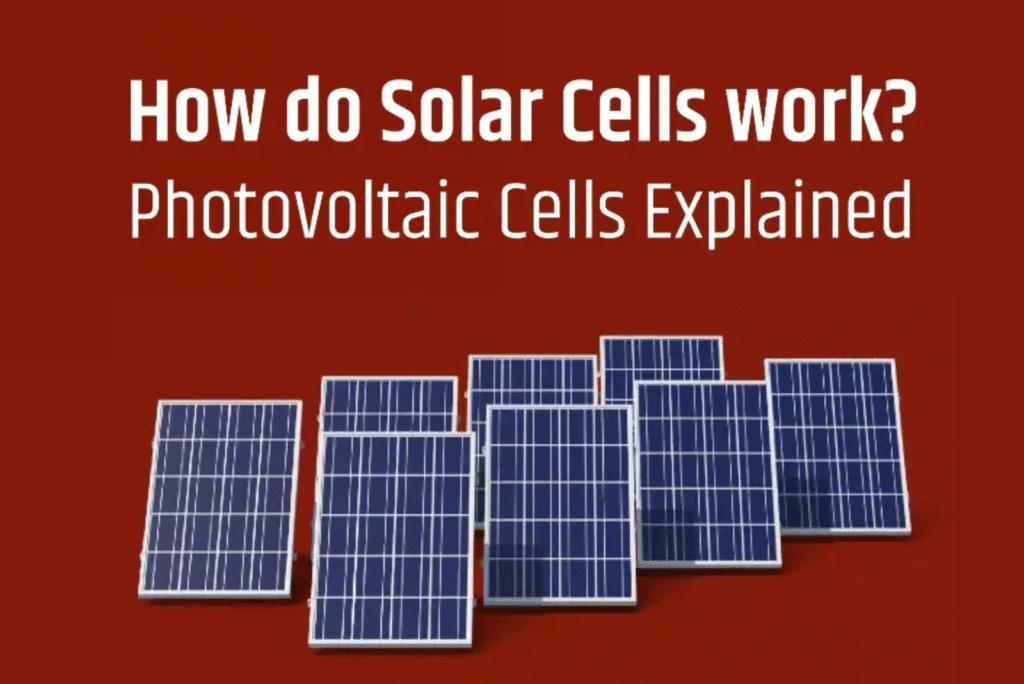
How do Solar Cells work? Photovoltaic Cells Explained Home Blogs Popular Posts All Posts Blog Seasonal Maintenance Tips for Solar… October 6, 2025 Solar Water Pump vs Regular… October 6, 2025 Rooftop Solar vs Ground-Mounted Solar October 6, 2025 Choosing the Best Solar Panel… October 6, 2025 Power Your Future with KLK Ventures Pvt. Ltd. Delivering reliable solar solutions for a sustainable tomorrow. Switch to clean energy and save with us today. Contact US Solar panels are everywhere around us. As the world is shifting towards solar energy, we can witness the increased use of solar panels. Whether it is solar roof-top systems, solar street lights, or solar pumps, solar panels are incorporated in every system. But what is behind the functioning of solar panels? It is the solar cells that make electricity generation possible. So, now the question is, how do these solar cells work? In this blog, we will focus on the working of solar cells and their importance in the whole solar panel system. Of course, this does not mean that individual efforts don’t count. At a smaller level, solar rooftop systems can contribute collectively towards the greater cause. The plus point? This boon for Earth is a boon for you, too. It will help you cut down your expenses and have a very efficient source of energy for your dream home. And, of course, you are playing your part as an aware citizen of society to share the burden of its current problems. What are Solar Cells? A solar module contains numerous components, and the most significant one among them is the photovoltaic cell. Also referred to as solar cells, the cells assist in the conversion of sunlight into electricity. Constructed from semiconductor materials, typically silicon, the photovoltaic cell traps the sunlight and releases electrons. The process generates an electric current. So, you may know by now that solar cells are a very significant component of solar panels. Solar panels are utilized in homes, buildings, and companies as well. The various solar panels are monocrystalline, polycrystalline, and thin-film solar panels. The Photovoltaic Effect Explained: How do Solar Cells Work? The solar cells function in three main steps: Light absorption and electron movement The flow of electrons generates electric current The same current is captured and directed to the wires This is how the photovoltaic effect takes place. Now, let’s go into the details of how each step takes place and what it leads to. Sunlight Absorption by Photovoltaic CellsThe whole process begins when the sunlight hits the surface of solar panels. As you already know, solar panels consist of solar cells. As the sunlight falls on the surface of solar panels, the photons react and transfer their energy to the cell. After the solar cells, which are made from a semiconductor material called silicon, absorb the sun’s energy, the electrons begin moving. Electron Flow Creates Electric CurrentSo in photovoltaic technology, there are generally two layers of silicon and each one is treated to create an electric field. This method is called “doping”. One side has a net positive charge, and the other side has a net negative charge. So the field directs the electrons in one single direction, causing them to generate an electrical current. Wires Capture and Transfer the CurrentTherefore, as soon as the electrons begin to flow, the metal plates on the solar cells gather them and transfer them to the wires. The electricity generated is in the form of Direct Current (DC), and thus through the wires it arrives at a solar inverter. The inverter transforms the direct current into an alternating current (AC). The alternating current is highly appropriate to be used within homes or buildings. The entire process is responsible for generating os electricity, which is subsequently transferred to different other locations. Nevertheless, an individual photovoltaic cell is unable to create much usable energy, so many solar cells are arranged in series to make up a solar panel. They are located on top of roofs, solar farms, and even in far-flung regions. Types of Solar Cells Today, we can see the use of two main types of solar cells: monocrystalline and polycrystalline. Although there are other types as well, like thin-film cells or organic cells, we commonly see the usage of these two the most. Monocrystalline Solar Cell Monocrystalline cells are made from silicon waters, and as the name suggests, they use a single crystal of silicon. Monocrystalline solar cells are highly efficient because of a single silicon crystal, which makes the flow of electrons easy. Polycrystalline Solar Cells These cells are also made from silicon; the only difference is that many shards of silicon are melted together, hence the name. Polycrystalline solar cells are less efficient than their counterpart, but the upside is that they are generally cheaper. So, you can find them being used in many solar panel systems today. How is a Photovoltaic Cell Made? Extraction of SiliconTo make solar cells, one needs silicon. Silicon is commonly found in rocks like crushed quartz and gravel. The raw materials are extracted and heated at high temperatures. This forms molten silicon, which is basically a product of the purification process. Creation of Silicon Wafers Now that we have, motlen silicon, it is left to cool down. The cooled silicon is then pressed into thin sheet-like wafers. These wafers, then, get cut into pieces for monocrystalline or polycrystalline solar cells. Doping the Silicon Doping the silicon refers to making the silicon conductive. We dope the silicon with boron to get a P-type silicon and with phosphorus to get an N-type silicon. Where these two silicon types interact, a p-n junction results, and an electric field is formed to permit the free movement of electrons. Anti-reflective coating Since silicon wafers possess a polished surface, sunlight is reflected off them. So to avoid it from happening, an anti-reflective coating is done. This also helps maximize the efficiency of solar cells. Adding of Metal Plates and Protective Layer Metal Contacts are used at
What is a Commercial Solar
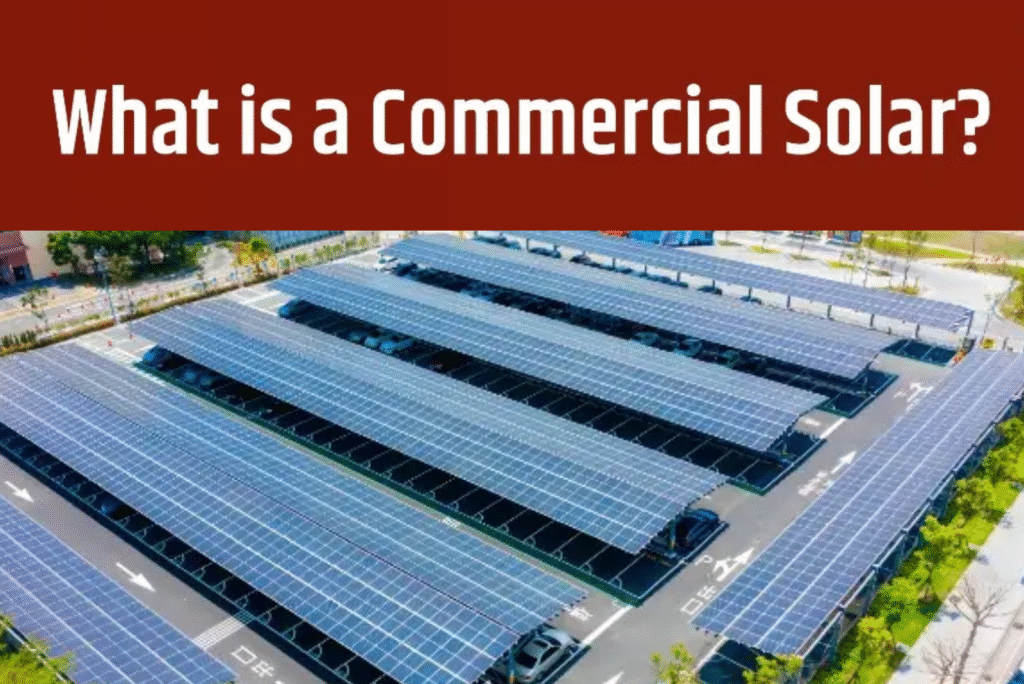
What is a Commercial Solar Home Blogs Popular Posts All Posts Blog Seasonal Maintenance Tips for Solar… October 6, 2025 Solar Water Pump vs Regular… October 6, 2025 Rooftop Solar vs Ground-Mounted Solar October 6, 2025 Choosing the Best Solar Panel… October 6, 2025 Power Your Future with KLK Ventures Pvt. Ltd. Delivering reliable solar solutions for a sustainable tomorrow. Switch to clean energy and save with us today. Contact US Solar energy is something you can find being used in our everyday lives. Well, it’s certainly important because the earth is burning from the torture of greenhouse gases. The fuel that fuels the world today is something that is fueling the pollution of the planet along with it. Commercial Solar systems have become one way to replace the use of such fossil fuels or non-renewable sources of energy. Solar street lighting or solar heating for buildings are examples of such a large-scale application that meets the needs efficiently. Of course, this does not mean that individual efforts don’t count. At a smaller level, solar rooftop systems can contribute collectively towards the greater cause. The plus point? This boon for Earth is a boon for you, too. It will help you cut down your expenses and have a very efficient source of energy for your dream home. And, of course, you are playing your part as an aware citizen of society to share the burden of its current problems. The Basic Idea Behind Solar Panels How does such an amazing, effective system come to effect? You must ponder on some random days the idea behind such a mechanism that essentially converts a free source – the sun’s energy – to something that becomes useful for us. A solar panel can be deconstructed into small solar cells. Just like the cells of a battery, they produce small amounts of energy that are then combined for use. It has wires running between these cells, connecting them and also giving a pathway to the charge that will be generated later.Some solar systems also have connected inverters that convert Direct Current to Alternating Current.Some solar panel systems also come with batteries that store energy for later use.In the case of Commercial Solar systems, a large number of such panels are used. These systems are often more complex and include solar power optimizers, energy management systems, and inverters to handle the larger power outputs. What is a Commercial Solar Panel? A Commercial solar panel is, well, unlike other solar panels designed for commercial use. They make the best solar panels for business. It also works on the principle of solar systems that collect the sun’s energy. This energy from sunlight is further converted by these photovoltaic cells into something magical we use daily. Yes, the electricity that runs households and companies. For commercial solar systems, these cells are made as a combination of both positively and negatively layered silicon. This forms the p-n junction, the most important component that produces an electric field, enabling the flow of electrons when the solar cell is subjected to sunlight. The photovoltaic effect takes place here, producing electricity. But we already know how a single solar panel is insufficient to meet the requirements of customers. So, many solar panels are wired together in a single, larger system; the configuration of this is known as a solar array or photovoltaic array. Such arrays may contain hundreds of individual panels, depending on how large the installation is. They all operate together to provide more electricity to power homes and businesses. Silicon, as a semiconductor, acts as a storehouse of electrons. When the sun’s rays hit its surface, the free electrons are released and merge with it to produce a charge that is further stored. Benefits of a Commercial Solar System Now, you are equipped with the basic knowledge and organisation of these commercial solar systems. It’s time to move ahead and explore all its advantages if we do opt for these advancements in our lives. Best for Commercial NeedsCommercial solar panels can be the best source of electricity for commercial use. This includes big plants, industries and organisations that have a large need for energy regularly. Commercial solar panels ensure a regularity of electricity supply to heavy power-using industries. They also ensure that there is no disruption of energy during daily operations. The functions can be carried out just like in the case of an on-grid system. Offers Security and ReliabilityCommercial Solar systems also provide security and reduce reliability on the grid systems. There can be a hybrid use of this with the grid energy systems to ensure that failure of it can be met with solar energy stored in excess. Cost-EffectiveThese solar panels for businesses will also impact the finances of organisations in a better way. After a one-time investment, this energy source is very easy to maintain and easy on the pockets, too. It’s good to increase profit and at the same time maintain a decent graph of productivity. Environmentally FriendlyA commercial solar system will, of course, contribute to the environment in the long run. Corporate sectors are heavy consumers of non-renewable energy. By replacing these sources, we will help the environment positively. Reduces Global WarmingAlso, in the case of the environment, another big benefit to achieve is the reduction of global warming. Again, installing solar systems on a large scale can help reduce the use of fossil fuels. AccessibilityEven for households and homes, large-scale motivation and installation of these solar plants will have a big impact. The installation of commercial solar panels can be done in remote areas to have their own local energy hub in the absence of grid systems. How are Solar Panels Made? Having been equipped with all the major pre-knowledge that one has to have, we are now ready to dive into how these panels are created. Step 1. The first step involves extracting silicon. The extracted silicon is purified through a chemical process. Step 2. The purified silicon is melted at very
How are Solar Panels Made?
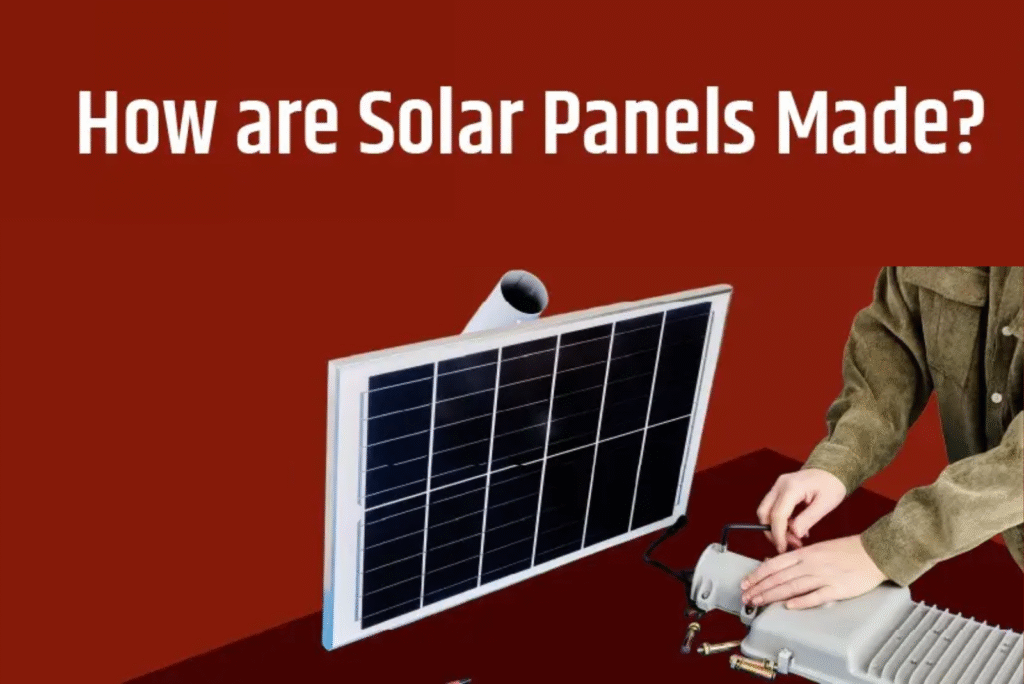
How are Solar Panels Made? Home Blogs Popular Posts All Posts Blog Seasonal Maintenance Tips for Solar… October 6, 2025 Solar Water Pump vs Regular… October 6, 2025 Rooftop Solar vs Ground-Mounted Solar October 6, 2025 Choosing the Best Solar Panel… October 6, 2025 Power Your Future with KLK Ventures Pvt. Ltd. Delivering reliable solar solutions for a sustainable tomorrow. Switch to clean energy and save with us today. Contact US There has been a shift in the consumption of energy resources over the years. Solar energy is taking the place of conventional energy resources and for good! The sun’s energy is being used to produce electricity and assist in fulfilling the energy requirements. Solar panels are a cutting-edge technology that has opened doors to a solution for the energy crisis. This is the reason why it becomes necessary to know everything about solar power systems. Solar energy is probably the best thing to ever exist, it’s effective, efficient and not harmful to our environment. Solar power systems make the best use of the sun’s energy possible. As we already know, solar panels are the visible and crucial part of this whole setup. So, what are the benefits of a solar rooftop system? And most importantly, why are solar panels so important for the solar power system? How do solar panels work? If these questions find a home in your mind, you are in the right place. Solar panels are undoubtedly good, but one must know how they are made and designed. This blog will help you find it all out! What is a Solar Panel? Solar Panels are like the lifelines that basically run the whole solar system. Before proceeding to the hows and whys of the process through which these solar panels are created, let’s look at what they are. In very simple terms, solar panels are one of the parts of the system that convert sunlight to electricity. The panels can then be used to power appliances and even electricity grids for our use. Generally, a single solar panel is not able to generate enough usable power. Hence, we often find them arranged together in groups to produce effective electricity. Solar panels, when in contact with sunlight, begin their energy production. The Photovoltaic Cells in these panels start generating free electrons, creating an electricity current. As households and businesses use alternating current electricity, the Direct Current (DC) is converted to Alternating Current (AC). The energy produced by them is then stored in batteries for later use. The solar storage helps in times of need (such as power outages or bad weather conditions). Application of Solar Panel Systems: Residential areasCommercial buildingsSolar FarmsAgricultural usesRemote locationsSolar pumps for rural areas What Are Solar Panels Made Of? Solar cells are typically made of silicon. It is the key component for creating electric energy. There are two forms of it: Monocrystalline silicon and polycrystalline silicon. Crystalline silicon is used for most of the solar cells that we see around. A tempered layer of glass is used to cover and protect the silicon cells. Apart from this, the connecting wires are often made from copper. Ethylene-vinyl acetate (EVA) surrounds and encapsulates the photovoltaic cells to protect them. Plastic, metal and glass are other crucial things needed to produce them. How are Solar Panels Made? Having been equipped with all the major pre-knowledge that one has to have, we are now ready to dive into how these panels are created. Step 1. The first step involves extracting silicon. The extracted silicon is purified through a chemical process. Step 2. The purified silicon is melted at very high temperatures to allow their formation to ingots. The ingots are cylindrical in shape, and the structure allows for slicing into thin sheets. During this process, however, the molten silicon is again cooled down after adding a pinch of phosphorus or boron to give it semiconductor properties. Step 3. The silicon ingots are sliced into thin wafers. These wafers are used as building blocks of solar cells. The wafer is similar to a sort of thin paper sheet. Step 4. Once these sheets have been obtained, they are coated for anti-reflection. This is done primarily to avoid the reflection of solar rays instead of their entrapment. Thin lines are cut for the flow of current in these cells. Step 5. These cells are either p-type or n-type. Positively charged (p-type) differ from one that’s negatively charged (n-type) in their composition of base and top layers. Step 6. Many such solar cells are brought together to form one solar panel. On average, one solar panel uses around 60 to 72 cells to function properly. A single cell produces very little energy. Step 7. A backsheet becomes important to cover and provide security to the back side of solar panels. It presents unwanted wear and tear, reducing the amount to be spent on maintenance later on. Step 8. The next action is the installation of a glass sheet to the front or the absorptive side of solar panels. Glass provides a transparent medium that protects the fragile solar cells. This does not hinder the access of sunlight to the solar panel. Step 9. A metal frame acts as a strengthening device. It provides a frame to the whole organisation of solar cells and other components. Going around the silicon, it also helps in fusing all layers. Step 10. The junction box is installed in the end to ensure the protection of all the wiring done in the solar panels. These panels can subsequently be connected to an inverter or different types of solar batteries. With this, our Solar panels get ready to be shipped and installed to different places for a variety of potential uses they can offer! Conclusion At KLK Ventures, you get the guarantee of supreme quality and the best of technology, offering highly efficient solar panels. There is a lot of choice available for you and according to your needs, we will help customize the best arrangement possible. Be it for household, industrial, or commercial
What are the Advantages and Disadvantages of Solar Street Light
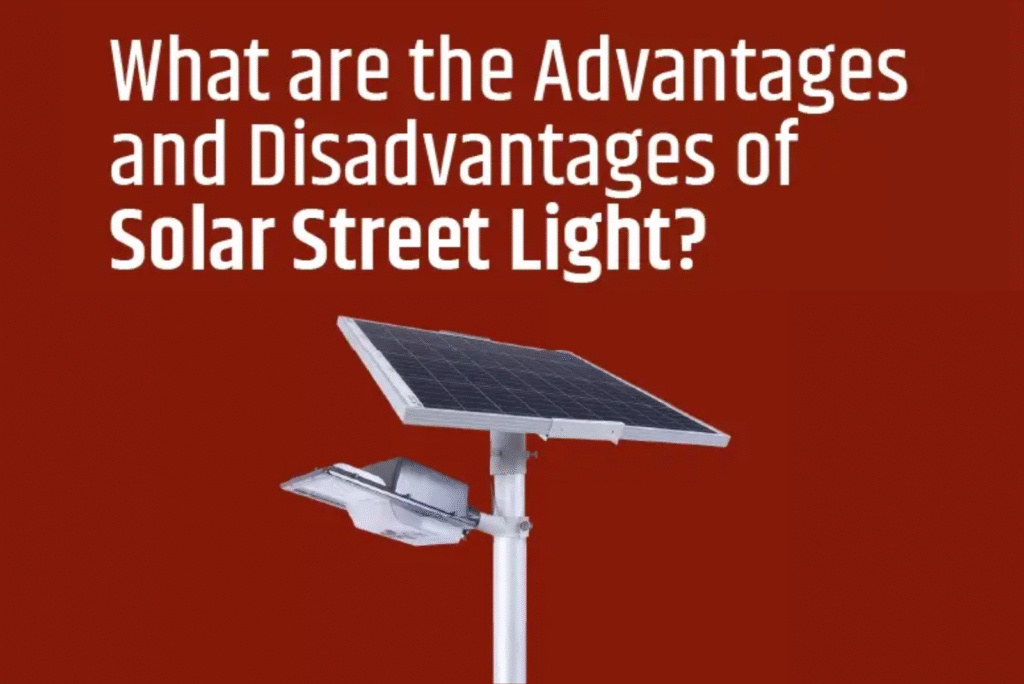
A Comparison of Grid-Tied, Off-Grid, and Hybrid Solar Systems Home Blogs Popular Posts All Posts Blog Seasonal Maintenance Tips for Solar… October 6, 2025 Solar Water Pump vs Regular… October 6, 2025 Rooftop Solar vs Ground-Mounted Solar October 6, 2025 Choosing the Best Solar Panel… October 6, 2025 Power Your Future with KLK Ventures Pvt. Ltd. Delivering reliable solar solutions for a sustainable tomorrow. Switch to clean energy and save with us today. Contact US As the world is rapidly moving towards a sustainable way of living, solar street lights are emerging as a perfect solar solution to outdoor lighting issues. These systems are not only efficient but also an environmentally friendly choice. But like any other technology, solar street lights have their own set of advantages and disadvantages. Let’s dive into the pros and cons of solar street lights. This will also help you decide if solar street lights are actually a better choice or not! What is a Solar Street Light? Before moving on to the advantages and disadvantages of a solar street light, let’s learn what it actually is. Solar street lights are a very intelligent discovery that provides high efficiency too. A solar street light, as the name suggests, operates the sun’s energy. They can be utilised to brighten any nook or corner of the region. Streets, roads, highways, etc can be easily laden with these sorts of street lights that work on the energy produced by photovoltaic panels. After the panels capture sunlight, it goes through the process of conversion into electricity that we are familiar with. For nighttime, batteries are used to store this energy. The solar lighting system involves solar panels, batteries, controllers and of course, most importantly, LED lights and solar street poles. How do Solar Street Lights Work? The solar light system is composed of a solar panel mounted atop the solar street pole. It is the one that absorbs sunlight and the photovoltaic cells that transform the same into electricity. The generated electricity from the solar panels finds its way to a rechargeable battery. At night, it is utilized, and it even assists the solar street lamps on cloudy days. The solar street lights have a sensor that assists them in automatically switching on during dusk or low light. The stored power lights up the LED bulbs which are efficient and usually bright. Advantages of Solar Street light There are many advantages to installing solar street lights. Let’s go through them: 1. Cost Savings on Electricity BillsYou must be aware of the fact that traditional street lights use grid electricity for power. This leads to high energy costs. Solar street lights, however, utilize the energy of the sun which is renewable. Besides the initial installation costs and routine maintenance, you will be saving on electricity bills. So, opting for solar street lights for your business or home is a smart decision. 2. Eco-friendly and SustainableSolar energy, in itself, is known for its eco-friendly properties. By depending on this sort of renewable energy source, our need for fossil fuels will decrease simultaneously. Since solar street lights harness the sun’s energy, they generate clean and green power. So, by choosing them, you are playing your part in being responsible for our planet. 3. Low Maintenance RequirementsTraditional lighting systems require frequent bulb replacements and repairs. In the case of solar street lights, you’ll be saved from such trouble! As these lights are designed to be durable. The LED bulbs used are highly efficient and have a longer life span. The battery systems are also built keeping in mind durability and cost-effectiveness. All this makes solar street lights a great solution for both remote and urban areas. 4. Reliable During Power OutagesSince solar street lights come with battery backups, they function independently of the grid. As they don’t rely on the grid for electricity, installing them can prove to be beneficial during bad weather conditions or unexpected power outages. These solar lights are especially beneficial for remote locations where grid electricity is inaccessible. A well-lit area also improves safety! 5. No Need for Complex WiringThese lights do not require lengthy wiring because they aren’t connected to the power grid. This makes them easy to install. For this reason, they are very well-suited to be installed in rural regions, highways, and disaster-prone regions since extending electrical infrastructures to these locations is a laborious and expensive affair. 6. Enhanced Safety and SecurityProper lighting, without any doubt, is very crucial. Solar street lights ensure light access to people on highways, in remote areas, and in parks. This will help positively in reducing crimes and accidents. Disadvantages of Solar Street Lights 1. Dependency on WeatherSolar street lights are powered by the light and energy of the sun. This reliability is absent in areas with limited or no sunlight. The areas which experience heavy rainfall or cloudy weather are not meant for solar street lights. 2. High Installation CostAs solar street lights come with a lot of components, the initial costs for installing them might be high. Added to this the cost of high-quality solar panels can raise the investment too. 3. Low BrightnessSolar street lights are only feasible for ordinary towns or roads. It does not provide the same intensity of electricity as provided by the traditional street lights. Due to this, they might not be suitable for areas that require powerful illumination. 4. Limited Battery LifeAlthough the batteries used for solar street lights are designed to last for years. However, due to continuous charging and discharging, their capacity gradually declines over the years. The battery might need to be replaced after every few years. This creates even more problems in areas where these lights are used more frequently. 5. High MaintenanceAlthough solar street lights receive free energy from the sun, some maintenance and cleaning services are necessary. This is to ensure that the lights keep working efficiently. 6. Big Spaces Required for Solar PanelsThe solar street lights consist of one important piece of equipment, that is solar panels.
A Comparison of Grid-Tied, Off-Grid, and Hybrid Solar Systems
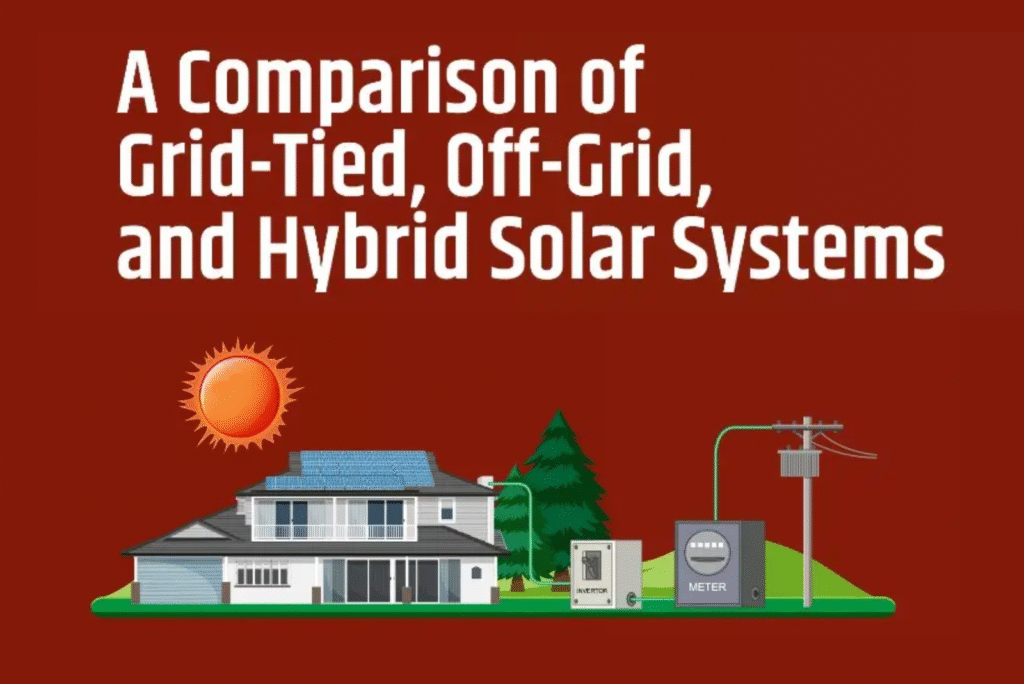
A Comparison of Grid-Tied, Off-Grid, and Hybrid Solar Systems Home Blogs Popular Posts All Posts Blog Seasonal Maintenance Tips for Solar… October 6, 2025 Solar Water Pump vs Regular… October 6, 2025 Rooftop Solar vs Ground-Mounted Solar October 6, 2025 Choosing the Best Solar Panel… October 6, 2025 Power Your Future with KLK Ventures Pvt. Ltd. Delivering reliable solar solutions for a sustainable tomorrow. Switch to clean energy and save with us today. Contact US Solar power systems have created a lot of buzz in the market, and rightly so because they are amazing! Sun is one source that is renewable and does not harm the environment when energy is derived from it. Solar panels hence, are amazing in reducing our carbon footprint while preserving depleting fossil fuels. Hence, all that hustle around this source of energy is justified! There are three types of solar panel systems: Grid-Tied solar system, Off-Grid solar system, and Hybrid solar system. These three systems are quite distinct and have different setups for working. If you are someone who wants to bring the gift of solar energy to your life, you should know about them all. A pre-knowledge about these different types of solar systems will allow for a more conscious choice for homes or businesses. KLK Ventures is here to sort you out of the confusion and technicalities, so do scroll down! Let’s compare grid-tied, off-grid, and hybrid solar systems to help you understand which one meets your requirements and criteria. What is a Grid-tied Solar System? Grid-tied Solar System, also known as the on-grid solar system, is connected to a local electricity grid. When solar panels generate electricity, homes or businesses use it along with the energy from the utility grid. It happens very often that solar panels sometimes generate electricity more than a house can consume. This electricity gets sent back into the grid. Through the advantage of net metering, utilities purchase the electricity and offer credits to the users which offsets their electricity bills. Pros of an On-grid Solar System (Grid-tied)Lower Initial Cost – No need for expensive batteries, making it the most affordable solar setup.Net Metering Benefits – Excess electricity can be sent to the grid for credits, reducing electricity bills.Efficient Energy Use – Since there are no battery losses, all generated power is either used or sent to the grid efficiently.Low Maintenance – Without batteries, maintenance requirements and costs are significantly lower. Cons of an On-grid Solar Power SystemNo Backup During Outages – If the grid goes down, the system shuts off for safety reasons, leaving you without power.Dependence on the Grid – Because of the connection to the utility grid, you’ll still rely on the grid for power. Because at night or during rain, the solar panels can’t generate electricity.No Energy Storage – Without any solar battery storage, the surplus energy will go to the grid. This means that you can’t store the energy for later use and will have to face power outages without solar power. What is an Off-Grid Solar System? Well, the name suggests how it’s off the grid, that it is independent of it. Off-grid solar systems are not connected to any utility grid that supplies electricity to our homes. This means they can absolutely function on their own. This self-sustained property is one of the many benefits of an off-grid solar power system for home. It will allow for less worry on your part regarding unexpected power outages. For rural or faraway lands that make it inaccessible to lay down a whole electricity grid, these can be a lifesaver. Since you get batteries as part of this whole, one can store electricity for later use easily. On one hand, we have high-tech metro cities, while on the other side, remoteness still lives in darkness. For those places, off-grid solar systems can grant the gift of a continuous electricity supply. Lighting up their world can make their lives much easier. Pros of off-grid solar power systemProtection from Power Outages – The solar power system will continue to function even if the utility grid goes down. You don’t have to rely on it for power during power outages or bad weather conditions.Eco-Friendly – The sun’s energy is renewable. Using these solar systems will help you reduce the use of fossil fuels, thus minimising carbon footprints.Energy Independence – Having a solar system will make you self-sufficient as you will no longer need to rely on the grid.Ideal for Remote Areas – The areas where electricity is inaccessible can heavily benefit from the off-grid solar power systems.Cons of off-grid solar systemsHigh Initial Cost – Batteries, inverters, and other equipment make off-grid solar systems more expensive.Requires Battery Storage – As the systems aren’t connected to the grid, you would require large battery storage to store the power. In this way, you will be able to use it in times of need.More Maintenance – With extra equipment, extra care is required. There’s a need to maintain Batteries for them to function properly.No Net Metering Benefits – Unlike grid-tied systems, you won’t get credits as you can’t send excess power to the grid. What is a Hybrid Solar Power System? The term hybrid refers to “a mixture of two distinct things.” For solar power systems, such a system incorporates both elements of off-grid and grid-tied systems. That is, the solar panel systems are linked with the solar batteries and the utility grid. The solar systems assist in the operation of storing surplus energy for use later and transferring it back to the grid. As the electricity is generated and kept for later use, you don’t have to rely on the grid completely. This will also minimise all your extra electricity costs. Although these solar systems are generally more expensive than the other two, they increase energy independence to a great extent. Pros of Hybrid Solar Power SystemReliable Power Supply – With backup sources and batteries, your house or business will get a continuous power supply when there’s no
Benefits of Off-grid Solar Power System For Home
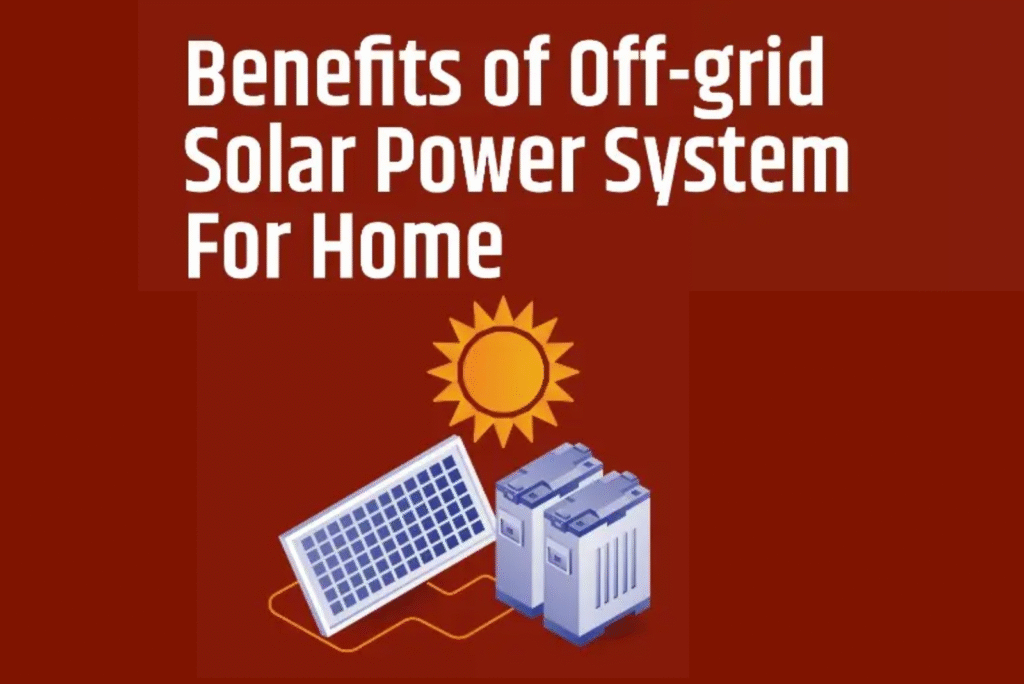
Benefits of Off-grid Solar Power System For Home Home Blogs Popular Posts All Posts Blog Seasonal Maintenance Tips for Solar… October 6, 2025 Solar Water Pump vs Regular… October 6, 2025 Rooftop Solar vs Ground-Mounted Solar October 6, 2025 Choosing the Best Solar Panel… October 6, 2025 Power Your Future with KLK Ventures Pvt. Ltd. Delivering reliable solar solutions for a sustainable tomorrow. Switch to clean energy and save with us today. Contact US Reliable access to electricity is still a challenge in many Indian households today. Although the use of fossil fuels is there, the harm they cause to the environment has made people rethink their choices. In today’s advanced world, off-grid solar power systems emerge as the best solution to tackle the problems of power cuts. With their non-polluting, environment-friendly features, off-grid solar systems are the topmost priority in every home nowadays. An off-grid solar power system provides a solution for homes to generate their own electricity. There are numerous benefits of a solar rooftop system that will help you avoid power outages and reduce electricity costs. These solar power systems present a great alternative form of energy for rural areas where there are always chances of power cuts. The present blog will explore more about the same and help you understand them better. This will help you choose the most effective solar system for your benefit. What is an Off-Grid Solar Power System? What is an Off-Grid Solar Power System?An off-grid solar power system works independently of the electrical grid. It generates electricity through the use of solar panels. This energy is stored in the batteries. As it is not dependent on the main power grid, it is an autonomous source of electricity working only through the energy supplied by the sun. As the name suggests, the solar power system promotes off-the-grid living and is the prime example of energy independence and self-sustainability. Off-grid systems are totally different from other traditional types of grid systems. Their features, efficiency and factors are unique and make them the first choice for consumers, especially in remote areas. Components of Off-grid Solar Power System Four main components are required for the complete installation of this solar power system: Solar panelsSolar panels are the prime and basic need for any solar power system. It is through which the whole process of the system can start and end effectively. Solar panels are a collection of thin layers of semiconducting material which collect the sunlight and convert it into direct current electricity. The batteries store this electricity in an off-grid solar power system. Charge controllerIt regulates the flow of electricity from the solar panels to the batteries. The application of a charge controller will ensure the batteries are not overheated because of overcharging. This guards the batteries and enhances the overall efficiency of the systems. BatteriesA battery is a crucial element since it holds the surplus electricity produced by the solar panels. This assists in producing power when the solar panels are not operational, for example, during nighttime. This is the reason why selecting the best among various types of solar batteries matters. InverterIt helps in converting the direct current (DC) stored in batteries to the alternating current (AC). This will make it compatible with the general household outlets. Cost of an off-grid solar power system The cost of an off-grid solar power system differs widely according to the different, applications and sizes available. The price not only includes the installation process but also the necessary components which will be needed for the installation process. It includes solar panels, inverters and batteries. When all these components come together, they make an efficient off-grid solar power system. The cost depends on various factors like technology, brand and service. It will differ widely depending on the brand that you choose. Benefits of Off-Grid Power Solar Systems Off-grid solar Power Systems can be beneficial for many. Especially for people struggling with high electricity bills or power outages in their homes. 1. Energy IndependenceAs power outages are unpredictable, they cause great inconvenience. One of the benefits of an off-grid solar power system is that it makes you energy-independent. You don’t have to depend on the electrical grid all the time. The only requirement is the sun’s energy which will ultimately power your house. 2. Easy Installation Since off-grid solar power systems do not depend on the grid, they can be installed anywhere. They do not require any complex equipment or processes, making installation quite straightforward and easier. 3. Energy Regulation Solar off-grid solutions provide you with autonomy over your electricity supply. Having this system in place is going to encourage you to regulate your energy spending more closely. This will allow for more conscious considerations on the part of customers which is highly appreciated. 4. Cost SavingWhen fossil fuels are primary sources of energy to date, they will continue to deplete and the prices will continue to increase. In this situation, if you use an unconventional source like a grid solar system, it will significantly become cost-effective for you. This system only relies on the sun to produce energy. As this energy is free, you should use it to reduce your costs. 5. AvailabilityThe ease of energy independence offered by these off-grid solar systems can be extended to supply electricity to remote places. These isolated places prove to be a challenge to supply electricity from conventional power lines. The presence of an off-grid solar system will enable people to meet their daily demands requiring electricity. 6. Uniformity Again, since off-grid power systems are highly reliable and accessible, they allow provisions for uniformity. One doesn’t have to experience blackouts and compromise with highly necessary electrical requirements. In cases of unforeseen events, the benefits of an off-grid solar rooftop system help. 7. Environment-FriendlyBurning fossil fuels emits greenhouse gases into the atmosphere. When you abandon them and adopt solar power systems, you benefit not only yourself but also the environment as a whole. Off-grid solar Power Systems prevent the environment
What Are the Different Types of Solar Batteries
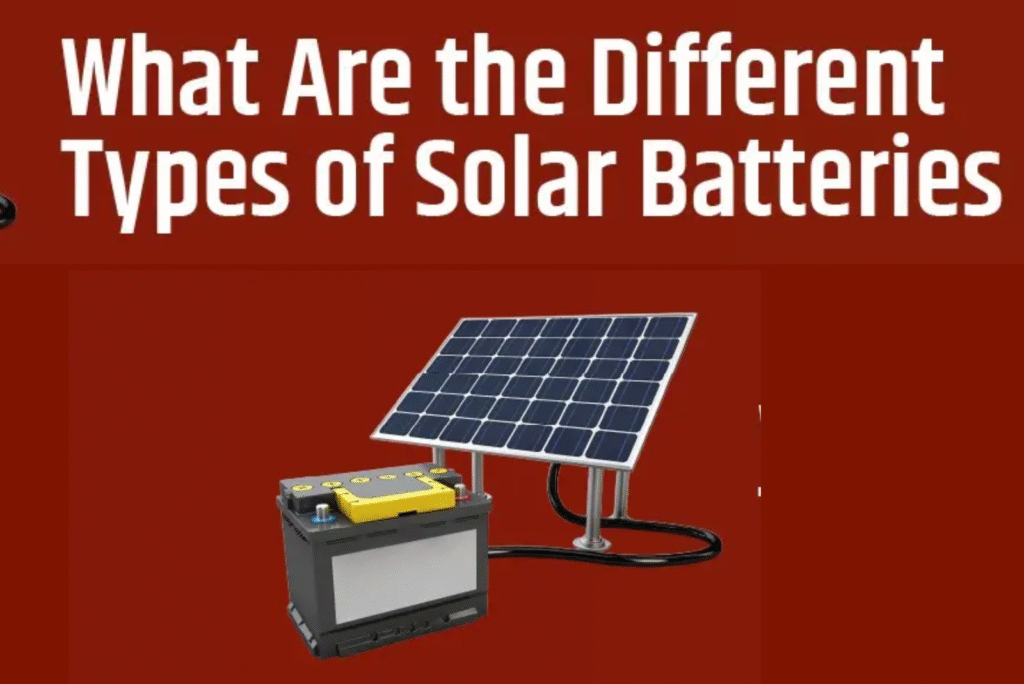
What Are the Different Types of Solar Batteries Home Blogs Popular Posts All Posts Blog Seasonal Maintenance Tips for Solar… October 6, 2025 Solar Water Pump vs Regular… October 6, 2025 Rooftop Solar vs Ground-Mounted Solar October 6, 2025 Choosing the Best Solar Panel… October 6, 2025 Power Your Future with KLK Ventures Pvt. Ltd. Delivering reliable solar solutions for a sustainable tomorrow. Switch to clean energy and save with us today. Contact US Knowing the type of solar batteries is an important factor if you are deciding to go solar or install solar panels. The selection of these batteries is important as they will be efficient and effective in the long run. Solar batteries are absolutely apt to be the perfect replacement for non-renewable sources. The connection of a solar battery to your solar panels can help you become more energy-independent. You won’t need to depend on the local grid anymore. It will lead to less carbon emissions and reduce electricity costs considerably. When looking for solar batteries for your home, two things are required- the type of solar battery you are looking for and the function of the battery that you need. KLK Ventures is dedicated to providing you with the best solar panels for home. With its efficiency, safety, and reliability, it helps you reach your energy goals while selecting the best type of solar battery. In the present blog, we elaborate on the most common types of solar batteries used. Looking through them, you will be guided to make the best transitional energy decision for your home. What is a Solar Battery? A solar battery is an extremely useful component, a vital part of the whole structure. It acts as a storehouse for all the excess energy produced. This extra energy can be used at times of unfavourable weather conditions that hamper solar power generation, that is, nighttime or cloudy days. The solar battery helps you use the excess solar energy you’re creating. If you don’t have battery storage, the excess electricity that solar power generates goes to the grid. This means that this electricity is helpful for other people and you are not using it for yourself abundantly. To avail of the benefits of solar panels properly, you need to install solar batteries. Types of Solar Batteries A solar battery is an extremely useful component, a vital part of the whole structure. It acts as a storehouse for all the excess energy produced. This extra energy can be used at times of unfavourable weather conditions that hamper solar power generation, that is, nighttime or cloudy days. The solar battery helps you use the excess solar energy you’re creating. If you don’t have battery storage, the excess electricity that solar power generates goes to the grid. This means that this electricity is helpful for other people and you are not using it for yourself abundantly. To avail of the benefits of solar panels properly, you need to install solar batteries. Types of Solar Batteries The four main, popular, and commonly used types of solar batteries are as follows: Lead-acid battery Lithium-ion batteries Nickel-based batteries Flow batteries These different types of batteries have unique functions, features, and their own advantages and disadvantages. They have unique characteristics that make them the priority when selecting the battery backup options. Now let us look at each of them in a detailed manner and what they have to offer. Lead Acid Battery A lead acid battery is composed of an electrolyte solution of sulphuric acid combined with lead plates. This chemical solution undergoes a reaction with these plates to ensure a continuous electric current flow. These types of battery systems are deep-cycle batteries, present in practice since the 1800s. Even now, such batteries are widely used because of the superior reliability they offer. They are mainly of two types. Flooded Lead Acid battery- These are the type of rechargeable battery containing a liquid electrolytic solution of sulfuric acid. Sealed Lead Acid battery- Also known as SLA batteries, they are completely closed with no requirement to check and clean the battery terminals. Advantages:Lead acid batteries are the first choice of customers for their affordability. They have been in wide use for decades and are especially popular when required in small businesses.The gel-type solar battery is safe to use. It does not contain liquid electrolytes and, therefore, prevents any type of leakage.Lead acid batteries are efficient for their recyclability because they can be reused many times. It is because they contain recycled lead.Lead acid batteries are also reliable, considering their superb performance since they came into being in the 1800s. Their reliability is the reason why they are so popular in different applications of solar power technologies.Disadvantages:Lead acid batteries don’t last for a longer period. They have a time span of two to five years.Although solar gel-type batteries require less maintenance, flooded lead-acid batteries need more maintenance. They need to be checked, and the battery terminals should also be cleaned frequently.Lead acid batteries have slow charging compared to other solar power systems. Lithium-ion Batteries Lithium-ion batteries are the new popularised form of batteries. They came into existence with the more usage of electric vehicles and are said to be the best type of batteries. A lithium-ion solar battery is made of lithium-ion cells connected in series or parallel. This increases the voltage or capacity. Advantages:The lithium-ion solar battery has a high density. It stores a great amount of energy and is the first choice for use in portable electronic systems.When compared to lead-acid batteries, lithium-ion batteries have a longer time span. They can be charged and discharged easily for many years without getting damaged.Solar Lithium batteries operate at different levels of temperatures. They will rarely degrade in performance.These batteries can be charged quickly. Therefore, they are more effective even in the time of low sunlight.Disadvantages:Lithium-ion batteries can sometimes be extremely dangerous to interact with. They require proper attention to the details pertaining to maintenance and storage.They are prone to risk in the conditions of extreme
Solar Street Lights: Types, Benefits & Applications
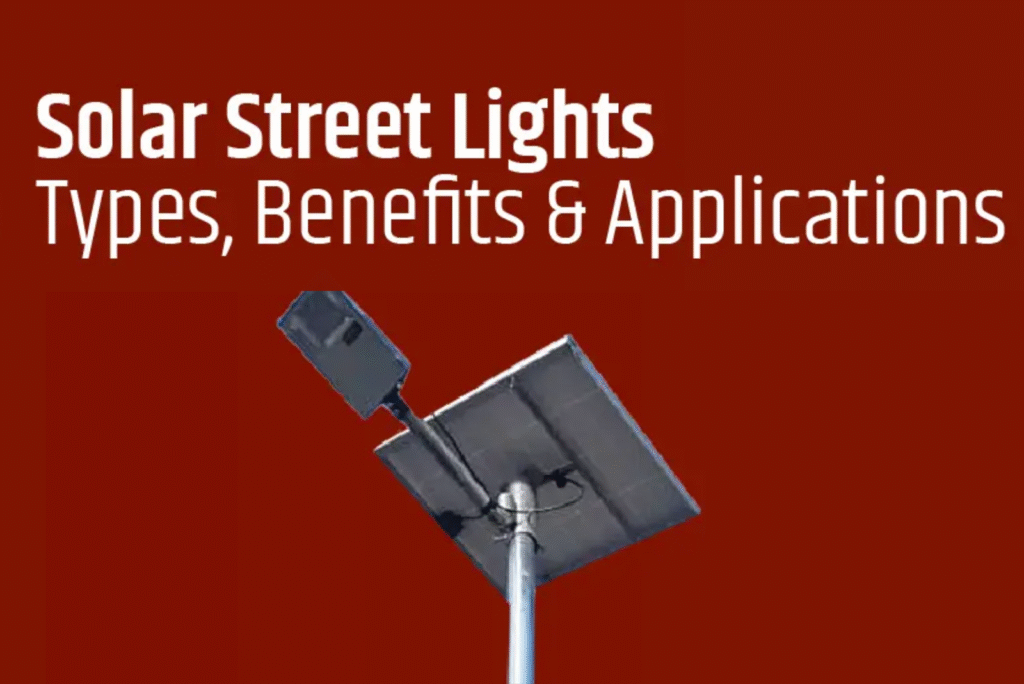
Solar Street Lights: Types, Benefits & Applications Home Blogs Popular Posts All Posts Blog Seasonal Maintenance Tips for Solar… October 6, 2025 Solar Water Pump vs Regular… October 6, 2025 Rooftop Solar vs Ground-Mounted Solar October 6, 2025 Choosing the Best Solar Panel… October 6, 2025 Power Your Future with KLK Ventures Pvt. Ltd. Delivering reliable solar solutions for a sustainable tomorrow. Switch to clean energy and save with us today. Contact US conventional light sources and hence, they have been a popular solution for outdoor lighting. Do you ever wonder what is that one thing that makes them amazing? Well, they are super cost-effective and environment-friendly for a start. If this somewhat prompts you to look at them as an alternative, make sure to have a good knowledge about the various types of solar street lights, their benefits and applications. The next few minutes of reading will enhance your understanding of the solar lighting system. What are Solar Street Lights? The sun’s energy is used to power the solar street light. Solar street lights are installed in such a manner that the solar panels soak in the sunlight and convert it into electricity. This electricity is stored for when the sun sets and evening arrives with hints of darkness. At nighttime, the LED bulb is powered by the battery. These are autonomous lights, i.e., they don’t use the grid. This also makes them a green option! The device consists of a rechargeable battery, a solar panel, an LED light, and a controller. Besides being useful and dependable, the system is also quite simple to maintain. How do Solar Lights Work? Photovoltaic (PV) solar panels which are installed on top of the street light pole or nearby, capture the sunlight in the daytime. These panels convert the sunlight into direct current (DC) electricity. Then, a charge controller regulates the voltage and current from the solar panels. This prevents overcharging and ensures the safety of batteries. These batteries store the electricity and power the street lights when there is no sunlight. High-efficiency LED lamps are used as the main light source. These are highly efficient and bright! A light control system consists of a timer or a light sensor, which automatically turns the LED lamps on in the evening. What are the Different Types of Solar Street Lights? All-in-Two Solar Street LightsThese lights combine three main components that are solar panels, a lithium battery, and an LED light source. This type of solar street lights allows for good placement of the solar panels. This, in turn, allows proper collection of sunlight for better electricity conversion. All-in-One Solar Street LightsThese solar street lights contain all, right from solar panels to controllers, within a single unit. Installation is easier as a result. There is no need to hassle because there are no individual wires to connect. Advantages of Solar Street LightsDo you also feel motivated to install this harbinger of advantages in your homes? Congratulations, your decision is going to be financially and environmentally sustainable. Let’s take a look at the different benefits of solar lighting: Environmentally FriendlyYou must be aware of the positive impact solar energy has on the environment. Solar street lights are very eco-friendly due to the sun’s energy. This energy is clean and renewable, which reduces our reliance on fossil fuels and ultimately leads to low emissions of greenhouse gases in the atmosphere. Low Operating CostsYes, you are about to save a large amount of money by installing solar lights! As all the costs are of installation alone, because of their longevity, these solar street lights last for a long time. And to top that off, they hardly require maintenance! Energy IndependenceThe solar panels that come with the solar street lights generate electricity and power the LED lamps. This makes them a reliable source of power. These lights are suitable for places that have no access to grid electricity. This feature makes them a very easy solution! Highly ReliableSolar street lights are made with reliability and proper functioning in mind. The robust components ensure that the lights withstand even bad weather conditions. So you can always count on these solar lights to help you in your hour of need. Energy Costs SavingThese solar street lights will save you electricity costs! With the sun being a free and abundant source of energy, you won’t need to depend on the grid for power. You will be generating your own electricity with the help of solar panels. This will save you unnecessary costs and bills! Safety and Community DevelopmentSolar lights will lighten up the dark places, even in the most remote locations! This will enhance visibility and give a sense of security and safety for all. This will also empower communities by providing access to a clean and sustainable source of energy. Uses of Solar LightingDifferent types of solar lights have different uses. The most common uses of solar street lights are: Residential AreasWho doesn’t want a safe neighbourhood? With the help of solar street lights, the paths will have high visibility. This reduces the chances of crimes and offers comfort. Solar lighting makes it easier to walk on the street and also lessens the chances of accidents. And all this is done at a very minimal cost! Parks and Public SpacesWhere there are individuals, there ought to be an appropriate lighting system. Solar street lights will make the parks well-lit, providing a safe and comfortable place for children and adults. There will be no need to rely on the local utility grid. Parking LotsSolar lights can illuminate dark parking lots that are hazardous. This is an inexpensive means of keeping the parking lots lit and visible. This offers security to workers and customers both! Roads and HighwaysIf there is any area that needs lighting the most, it’s the roads and highways. Solar street lights provide constant illumination on roads and highways, reducing the chances of accidents. This turns out to be very safe for drivers and even pedestrians as there is an
What are the Benefits of a Solar Rooftop System?

What are the Benefits of a Solar Rooftop System? Home Blogs Popular Posts All Posts Blog Seasonal Maintenance Tips for Solar… October 6, 2025 Solar Water Pump vs Regular… October 6, 2025 Rooftop Solar vs Ground-Mounted Solar October 6, 2025 Choosing the Best Solar Panel… October 6, 2025 Power Your Future with KLK Ventures Pvt. Ltd. Delivering reliable solar solutions for a sustainable tomorrow. Switch to clean energy and save with us today. Contact US The sun, as a source of light and heat, is one of the main reasons for the survival of planet Earth. Compared to conventional sources of energy, the sun is a renewable energy resource that provides unlimited energy. Since we receive the sun’s energy in abundance, we sometimes forget to value its benefits. You must be well aware of the modern technologies that convert solar power into electricity. This general transition from heat to electricity happens through a solar rooftop system. Solar rooftop is beneficial for us as well as for the environment. It reduces the use of conventional sources of energy and this leads to less emission of greenhouse gases into the atmosphere. This ultimately leads to less pollution in the environment. KLK Ventures provides the best energy solutions and installation of solar rooftop systems. This blog further enumerates the workings and benefits of solar systems. The working of the Solar Rooftop System In the present times, solar rooftop systems are not only used in large solar farms but also in small homes and small to medium business organisations. Now let us know about the working after the installation of the solar rooftop system. Also read: how do solar panels work? The solar rooftop system is made from a collection of solar panels and the necessary equipment required along with it. These solar panels are installed on a roof to convert the sunlight into electricity.The process takes place with the help of photovoltaic cells. These solar cells are made of semi-conducting materials, which helps in the conversion of heat energy.You can use the electricity generated from these systems for self-consumption and also sell it to the distribution companies for extra income Types of Solar Rooftop System 1. On-Grid Solar Rooftop SystemOn-grid solar rooftop system is the most common and popular type of system used. It is connected to a grid. This helps in the transfer of power between the grid and the system. When the solar system becomes inefficient, sometimes, they can harness power through the grid. If the electricity is in excess, it can also be supplied back into the grid. 2. Off-Grid Solar Rooftop System The off-grid solar power system works without a connection to the grid. They are most commonly used in remote and less developed areas that have no access to the grid. The batteries connected to them store the excess electricity during the daytime. They also contain backup generators, which maintain the continuous supply of electricity required in bad weather conditions. 3. Hybrid Solar Rooftop System This type of solar rooftop system amalgamates the features of both on and off-grid systems. It contains batteries to reduce the dependence on a grid system. This helps in the generation of electricity when the grid supply is not constant, or demand is at its peak. Hybrid systems also contain backup power generators, which come into use when the grid is down. Benefits of Solar Rooftop System Solar panels are beneficial to homeowners who can enjoy their benefits, save money and simultaneously increase the value of their homes. Now let us look at some of the benefits of the solar system which make it the top priority in every circumstance: Solar Rooftop System is the cheapest form of sourceSun is a renewable source of energy. Since it is a never-exhausting resource, it saves electricity bills significantly. It also helps in the generation of electricity during times of need or when there is a power shortage. Money SaverThe Solar Rooftop system saves you money by generating electricity from the sun’s energy. This helps in lowering your electricity bills. You can also sell the electricity to distribution companies if it is produced in excess. No issue of power outagesIf there is a power cut, the solar rooftop system helps deal with it. The hybrid solar system paired with the generator provides power regardless of the time of day. Increased ValueImagine the best solar rooftop system in your house. It will make your house more amazing and increase its value. The installation of solar panels will serve as a future investment for your house if you ever decide to sell it. Works well despite weather conditionsFor the solar rooftops, you just need one thing, and that is sunshine. Even a few hours of dim light in the winter helps in the charging of solar panels. In the rainy season, there are more chances of power disruption. However, the solar rooftop system will solve this problem as well. Environment FriendlyApart from all the benefits which affect us at personal levels, let us not forget about the huge contribution of solar rooftop systems to the environment. Solar energy is a green and sustainable form of energy. By using it, you are helping the environment, too, making the future sustainable. ConclusionAt KLK Ventures, we assure you that we will make your journey towards energy transition a smooth one. Reduce your energy bills and enjoy the amazing features of solar rooftop systems by putting your trust in us. KLK Ventures caters to your needs while offering financial benefits. Our experienced team of professionals will provide a hassle-free installation of solar rooftop systems. We offer you more reliability, the best guarantee and management. Therefore, don’t wait any longer! Step forward and play your part towards nature’s welfare.
Top 8 Reasons Why Solar Panels Are Beneficial
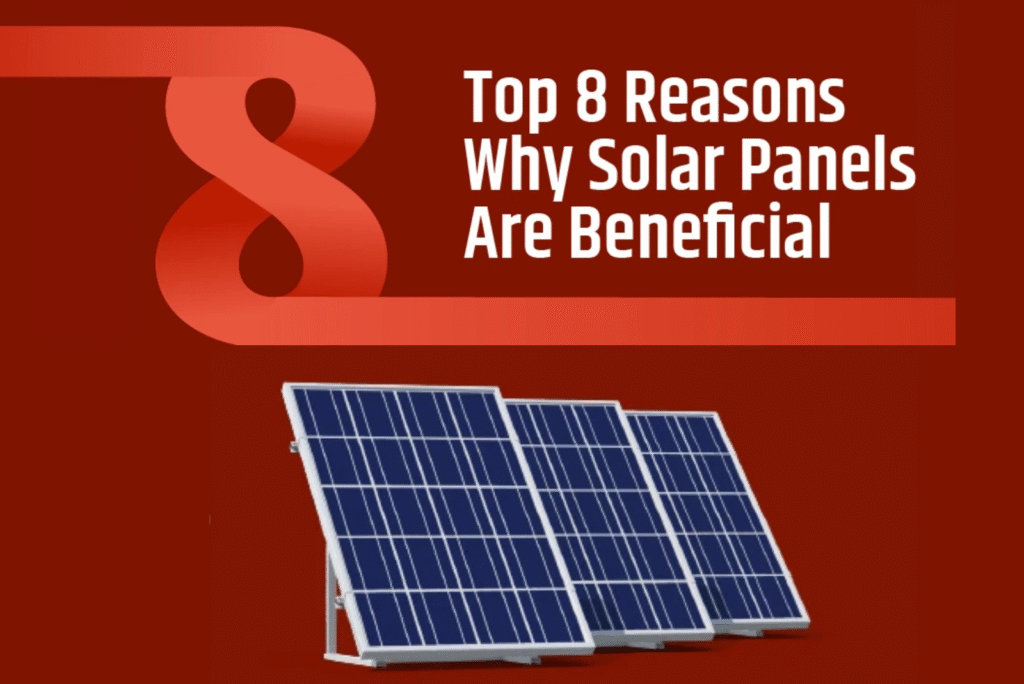
Top 8 Reasons Why Solar Panels Are Beneficial Home Blogs Popular Posts All Posts Blog Seasonal Maintenance Tips for Solar… October 6, 2025 Solar Water Pump vs Regular… October 6, 2025 Rooftop Solar vs Ground-Mounted Solar October 6, 2025 Choosing the Best Solar Panel… October 6, 2025 Power Your Future with KLK Ventures Pvt. Ltd. Delivering reliable solar solutions for a sustainable tomorrow. Switch to clean energy and save with us today. Contact US The sun is the biggest source of energy, which provides us with light and heat. It is a long-lasting and unlimited source. It contributes towards the harnessing of solar energy. Solar energy is a renewable resource which produces different forms of energy like electricity, heat energy, and many other things. It leads to a sustainable environment with zero emission of greenhouse gases into the atmosphere. It is one of the cleanest and purest forms of energy used for battery charging, cooking, solar water heaters, etc. Solar energy works through different mediums like solar panel, solar thermal power and solar updraft power. Amongst these, solar modules, also known as solar panels, are the most popular and widely used. These are the cheapest and most abundant forms of electricity consumption. But what is a solar module? What is a Solar Panel? Solar panels process sunlight into electricity through these photovoltaics, aka solar cells. These cells are comprised of materials like silicon, boron, phosphorus and others. The cells are arranged in a pattern in the form of a grid on the surface of the solar panel. Installation of solar panels does not cause any harmful effect on the environment and leads to no global warming. You become more energy-independent with no usage of fossil fuels, thereby making the future more bright and sustainable. KLK Ventures is a trusted provider for your rooftop solar panel installation. We guarantee you the best management and the installation of the best solar panels in India. How do Solar Panels work? The photovoltaic cells (generally made of silicon) on the surface of the solar panel absorb the sunlight. The sun’s energy creates an electric charge as the electrons move. The movement generates direct current (DC) and flows through the panel’s wiring. But this direct current can’t be used by households, so this current is then sent to the inverter. It converts it to alternating current (AC). The AC electricity then powers your home or business. Different Types of Solar Panels Monocrystalline – Monocrystalline solar panels are one of the most efficient types, which are made from high-quality silicon. These panels are highly efficient than any other type of solar panel. They typically last for about 25 years and prove to be worth your investment. Polycrystalline – Polycrystalline solar panels are made from thin pieces of silicon combined. They are generally cheaper than the monocrystalline panels and work well for residential usage. Other solar panels, such as thin-film, transparent, and hybrid, can be selected based on your area, budget, and location. What are the Advantages of Installing a Solar Panel? Now, let us know about some of the advantages of solar panels. Below are mentioned some of the points which will surely compel you to avail the benefits of the installation of the best solar panels in India: Reduction in the electricity bills: Solar Panels allow you to generate your electricity. This means that your cost of electricity bills will be significantly low. You can also sell the surplus electricity to the distribution companies. This will generate extra income for a person belonging to a middle or lower-class background.Renewable Energy Resource: Solar Panels are a renewable source of energy. It cannot be used up with the sun shining and solar panels generating electricity. You don’t need to worry about the power running out because the sunlight hitting panels generate free and clean energy.Environment Friendly: Since the energy produced by solar panels is clean and renewable, it will not emit greenhouse gases into the atmosphere.Property value: After installing solar panels on your rooftops, the value of your place will significantly increase. These solar panels will prove to be an upgrade to your home. If you ever decide to sell your house, the solar investment will make you profit.Low maintenance and reliability: With the technology advancing, the maintenance of solar panels has become much easier. The system is designed in such a way that it requires only minimal effort to maintain it. It only needs to be cleaned a few times a year. KLK Ventures guarantees you easy maintenance with a team of well-experienced professionals.Reliable source of energy: Solar Panels generate an ample amount of electricity during the middle of the day or early afternoon, which is then used in the night. The energy stored during this time will reduce the pressure on the power grid and help you in your time of need (for example, a power failure).Rewards from the government: Another benefit of solar panels is the rebate which can be received from the government. You can sell the energy back to the government in return for the cash. This will be a great opportunity for the homeowners to go solar.Long-term investment: Investing in solar panels means bearing only the cost of the installation and minimal services. Because the energy a solar panel produce is free and in abundance, this will prove to be very beneficial. Above mentioned are some of the benefits of the solar panels. Apart from these, you have many more reasons to opt for this energy transition. Hence, do not wait any more! Install solar panels on the rooftops of your houses as soon as possible. You will get the best installation, maintenance, and energy efficiency consultations. Long-lasting warranties are a big benefit of solar panels, and this warranty is provided by only KLK Ventures. Global climate change makes it important for us to contribute our part towards the planet Earth. For some people, the installation of solar panels is costly. However, this problem is also solved by the government of India. Through the PM Surya Ghar
